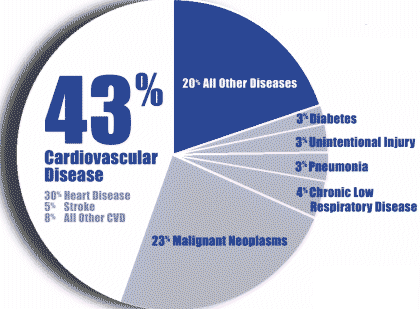MAJOR CVDs::::
1. coronary( ischaemic) = heart attack,
2. cerebrovascular disease( stroke),
3. HIGH blood pressure,
4. heart failure
5. Rheumatic heart disease
TYPE OF :::
1. CORONARY - disease of blood vessels supplying heart muscle
2. CEREBROVASCULAR - disease of blood vessel supplying brain ( stroke)
3. PERIPHERAL ARTERIAL DISEASE - disease of blood vessels supplying the arm and legs
4. RHEUMATIC - damage to the heart muscle n valves from rheumatic fever
5. CONGENITAL - malformations of heart structure existing at birth
6 DEEP VEIN THROMBOSIS N PULMONARY EMBOLISM - blood clots in leg veins can dislodge n move to the heart n lungs
RISK FACTORS
Behavioral risk factors ::::
unhealthy diet, physical inactivity, tobacco use
NON MODIFIABLE >>> SEX, HEREDITARY, RACE, AGE N PERSONALITY TYPE
MODIFIABLE >>>>>>> high blood pressure, high blood cholestrol, smoking, pysical inactivity, obese, diabetes, stress
CHOLESTROL
- chylomicrons
- VERY low Density Lipoprotein
- low density lipoprotein ( bad, increase risk of CHD, major component of artherosclerotic plaque that clogs arteries, < 130 mg/dL)
- high density lipoprotein ( GOOD, help scout the wall of blood vessels, clean excess cholestrol, carry excess cholestrol to the liver for processing, >35mg/dL)
SATURATED FAT >>>> increase level of LDL, decrease HDL, increase total cholestrol
POLYUNSATURATED FAT >>>> help body get rid of newly formed cholestrol
MONOUNSATURATED FAT>>> decrease total cholestrol, lower LDL levels
TRANS FATTY ACIDS >>>>>>> raise total and bad cholestrol, in fast food meals
OMEGA 3 >>>>>>>>>>>>>>>> type of PUFA ,lower serum trygliceride, lower BP, found in salmon, tuna
TYPE OF CVD
1. CONGESTIVE HEART FAILURE
- inability of the heart to keep up its work load of pumping blood to the lungs and to the rest of body
- heart not doing efficient job
- right side collect blood that return from body n send to lung. if it fail then it will lead to edema
- left side reserve blood from lungs and pump out into body. if fail the blood not pumped effectively.
>>>SYMPTOMS
= involve gravity or exhaustion of heart
~ swelling of ankle, legs, hands
~orthopnea @ shortness of breath
~ shortness of breath during exertion
= involve circulation
~ cyanosis or bluish color in lips n fingernails
~ fatigue or weakness
~rapid or irregular heart beat
~behavior changes
=involving congestion
~unexplained weight gain
~chronic cough
~increased urination
~ loss of appetite or indigestion
2. CORONARY ARTERY DISEASE
- coronary arteries that supplY heart muscle blocked
- partially blocked n cause angina ( chest pain or discomfort you get when your heart muscle does not get enough blood)
- fully blocked cause myocardial infarction
SYMPTOMS
= Chest pain is a major symptom of heart attack. You may feel the pain in only one part of your body, or it may move from your chest to your arms, shoulder, neck, teeth, jaw, belly area, or back.
The pain can be severe or mild. It can feel like:
- A tight band around the chest
- Bad indigestion
- Something heavy sitting on your chest
- Squeezing or heavy pressure
The pain usually lasts longer than 20 minutes. Rest and a medicine called nitroglycerin may not completely relieve the pain of a heart attack. Symptoms may also go away and come back.
Other symptoms of a heart attack include:
- Palpitations (feeling like your heart is beating too fast or irregularly)
- Sweating, which may be extreme
Some people (the elderly, people with diabetes, and women) may have little or no chest pain. Or, they may experience unusual symptoms (shortness of breath, fatigue, weakness). A "silent heart attack" is a heart attack with no symptoms.
3. RHEUMATIC HEART DISEASE
- result from rheumatic fever which affects connective tissue
- group A streptococcus infection
4. STROKE
-tissue damage to area of brain due to insufficient blood supply n oxygen
- blood vessels in brain blocked by artheroclerosis n embolus
- causes
~ infarction :: blockage in cerebral artery that cuts off or reduce blood supply
~ hemorrhage
RISK FACTORS of STROKE::::: age, high blood pressure, smoking, heart disease, high red blood cell count, mini -strokes
SYMPTOMS of STROKE :::::: sudden numbness of face, arm or leg n one side of body, confusion n trouble speaking, trouble seeing, trouble walking, dizziness
EFFECT of STROKE ::::::: motor, sensory, cognitive n speech impairment, paralysis, left hemisphere damage= language problem ( receptive n expressive aphasia), right side = difficulties in visual processing n emotions
PREVENTION OF ALL CARDIOVASCULAR DISEASE
~ SCREENING N DIAGNOSIS
= Electrocardiogram
= Stress test
= Coronary angiography
= blood test
= chest x-ray
~ DIETARY CONTROL
~EXERCISE
~ SMOKING CESSATION










1 comment:
I was curious if you ever considered changing the
layout of your website? Its very well written; I love what youve got to say.
But maybe you could a little more in the way of content
so people could connect with it better. Youve got an awful lot of text for only having 1 or two pictures.
Maybe you could space it out better?
my web blog ... http://www.nexopia.com/users/attackjame92/blog/1-clenbuterol-diet-plan-testimonial
Post a Comment